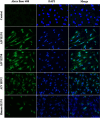Evidence of avian and human influenza A virus infection in farmed Siamese crocodiles (Crocodylus siamensis) in Thailand
- PMID: 39774465
- PMCID: PMC11706503
- DOI: 10.1371/journal.pone.0317035
Evidence of avian and human influenza A virus infection in farmed Siamese crocodiles (Crocodylus siamensis) in Thailand
Abstract
Crocodilians are susceptible to a range of virus infection including influenza A virus (IAV). However, little is known about the ecology and epidemiology of IAV in crocodile species. This study aimed to investigate IAV infection in farmed Siamese crocodiles in central Thailand. We collected plasma samples and pharyngeal swab samples from Siamese crocodiles residing in 13 crocodile farms in 9 provinces of central Thailand during 2019. Additional archival plasma samples of Siamese crocodiles collected in 2012 and 2018 were also included in the study. Plasma samples were screened for influenza A antibodies by a hemagglutination inhibition (HI) assay and positive were evaluated by a cytopathic effect/hemagglutination based-microneutralization (MN) assay. Swab samples were tested for influenza viral RNA by a real-time RT-PCR assay targeting the influenza matrix (M) gene. Among 246 tested plasma samples, the overall seroprevalence of antibodies against IAV in farmed Siamese crocodiles was 17.5% (43/246). The most common hemagglutinin (HA) subtype was H2 (46.5%, 20/43) followed by H9 (39.5%, 17/43), human H1 (14%, 6/43) and H1 (7%, 3/43). Multiple HA subtypes were also detected in 7% (3/43) of infected crocodiles with combination of H1 and H2 subtypes. All 126 tested swab samples were negative for influenza viral RNA. In addition, we demonstrated the ability of wild-type IAV subtypes (H1, H2, H9 and human H1) to infect primary Siamese crocodile fibroblast cells. To our knowledge, this is the first report of serological evidences of avian and human IAV infection in Siamese crocodiles. Our findings highlighted the role of crocodile species in the ecology of IAV particularly the potential to serve as the reservoir or mixing vessel for the viruses that significantly threaten both human and animal health.
Copyright: © 2025 Thongdee et al. This is an open access article distributed under the terms of the Creative Commons Attribution License, which permits unrestricted use, distribution, and reproduction in any medium, provided the original author and source are credited.
Conflict of interest statement
The authors have declared that no competing interests exist.
Figures



References
MeSH terms
Substances
LinkOut - more resources
Full Text Sources

